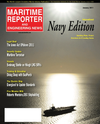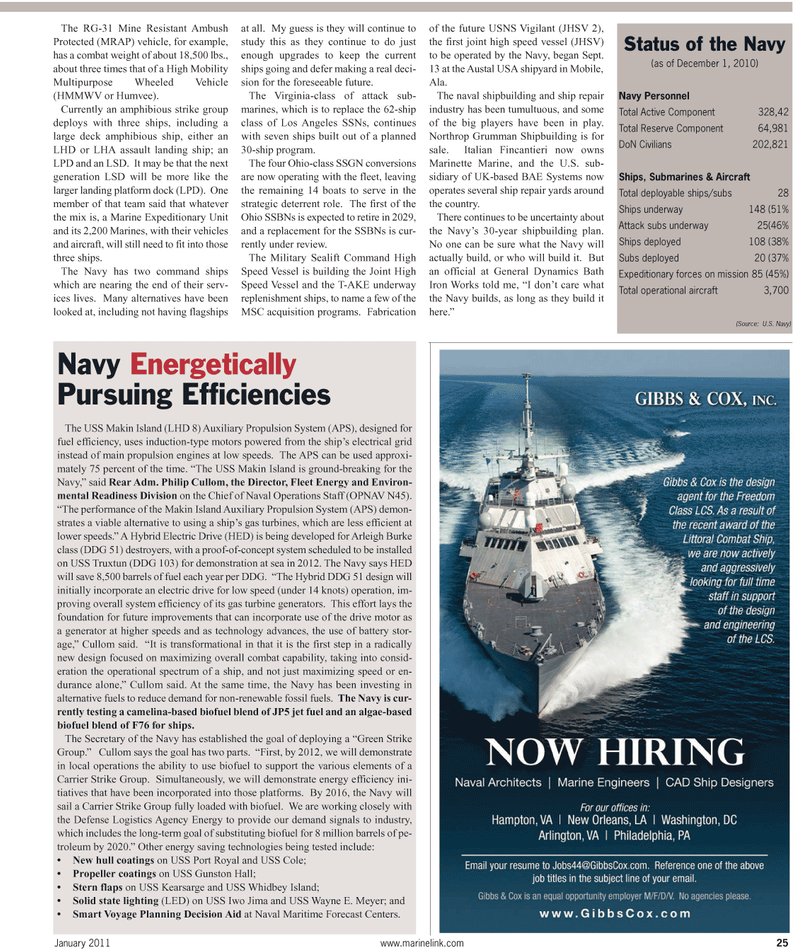
Page 25: of Maritime Reporter Magazine (January 2011)
International Naval Technology
Read this page in Pdf, Flash or Html5 edition of January 2011 Maritime Reporter Magazine
The RG-31 Mine Resistant Ambush
Protected (MRAP) vehicle, for example, has a combat weight of about 18,500 lbs., about three times that of a High Mobility
Multipurpose Wheeled Vehicle (HMMWV or Humvee).
Currently an amphibious strike group deploys with three ships, including a large deck amphibious ship, either an
LHD or LHA assault landing ship; an
LPD and an LSD. It may be that the next generation LSD will be more like the larger landing platform dock (LPD). One member of that team said that whatever the mix is, a Marine Expeditionary Unit and its 2,200 Marines, with their vehicles and aircraft, will still need to fit into those three ships.
The Navy has two command ships which are nearing the end of their serv- ices lives. Many alternatives have been looked at, including not having flagships at all. My guess is they will continue to study this as they continue to do just enough upgrades to keep the current ships going and defer making a real deci- sion for the foreseeable future.
The Virginia-class of attack sub- marines, which is to replace the 62-ship class of Los Angeles SSNs, continues with seven ships built out of a planned 30-ship program.
The four Ohio-class SSGN conversions are now operating with the fleet, leaving the remaining 14 boats to serve in the strategic deterrent role. The first of the
Ohio SSBNs is expected to retire in 2029, and a replacement for the SSBNs is cur- rently under review.
The Military Sealift Command High
Speed Vessel is building the Joint High
Speed Vessel and the T-AKE underway replenishment ships, to name a few of the
MSC acquisition programs. Fabrication of the future USNS Vigilant (JHSV 2), the first joint high speed vessel (JHSV) to be operated by the Navy, began Sept. 13 at the Austal USA shipyard in Mobile,
Ala.
The naval shipbuilding and ship repair industry has been tumultuous, and some of the big players have been in play.
Northrop Grumman Shipbuilding is for sale. Italian Fincantieri now owns
Marinette Marine, and the U.S. sub- sidiary of UK-based BAE Systems now operates several ship repair yards around the country.
There continues to be uncertainty about the Navy’s 30-year shipbuilding plan.
No one can be sure what the Navy will actually build, or who will build it. But an official at General Dynamics Bath
Iron Works told me, “I don’t care what the Navy builds, as long as they build it here.”
January 2011 www.marinelink.com 25
Navy Energetically
Pursuing Efficiencies
The USS Makin Island (LHD 8) Auxiliary Propulsion System (APS), designed for fuel efficiency, uses induction-type motors powered from the ship’s electrical grid instead of main propulsion engines at low speeds. The APS can be used approxi- mately 75 percent of the time. “The USS Makin Island is ground-breaking for the
Navy,” said Rear Adm. Philip Cullom, the Director, Fleet Energy and Environ- mental Readiness Division on the Chief of Naval Operations Staff (OPNAV N45). “The performance of the Makin Island Auxiliary Propulsion System (APS) demon- strates a viable alternative to using a ship’s gas turbines, which are less efficient at lower speeds.” A Hybrid Electric Drive (HED) is being developed for Arleigh Burke class (DDG 51) destroyers, with a proof-of-concept system scheduled to be installed on USS Truxtun (DDG 103) for demonstration at sea in 2012. The Navy says HED will save 8,500 barrels of fuel each year per DDG. “The Hybrid DDG 51 design will initially incorporate an electric drive for low speed (under 14 knots) operation, im- proving overall system efficiency of its gas turbine generators. This effort lays the foundation for future improvements that can incorporate use of the drive motor as a generator at higher speeds and as technology advances, the use of battery stor- age,” Cullom said. “It is transformational in that it is the first step in a radically new design focused on maximizing overall combat capability, taking into consid- eration the operational spectrum of a ship, and not just maximizing speed or en- durance alone,” Cullom said. At the same time, the Navy has been investing in alternative fuels to reduce demand for non-renewable fossil fuels. The Navy is cur- rently testing a camelina-based biofuel blend of JP5 jet fuel and an algae-based biofuel blend of F76 for ships.
The Secretary of the Navy has established the goal of deploying a “Green Strike
Group.” Cullom says the goal has two parts. “First, by 2012, we will demonstrate in local operations the ability to use biofuel to support the various elements of a
Carrier Strike Group. Simultaneously, we will demonstrate energy efficiency ini- tiatives that have been incorporated into those platforms. By 2016, the Navy will sail a Carrier Strike Group fully loaded with biofuel. We are working closely with the Defense Logistics Agency Energy to provide our demand signals to industry, which includes the long-term goal of substituting biofuel for 8 million barrels of pe- troleum by 2020.” Other energy saving technologies being tested include: • New hull coatings on USS Port Royal and USS Cole; • Propeller coatings on USS Gunston Hall; • Stern flaps on USS Kearsarge and USS Whidbey Island; • Solid state lighting (LED) on USS Iwo Jima and USS Wayne E. Meyer; and • Smart Voyage Planning Decision Aid at Naval Maritime Forecast Centers.
Status of the Navy (as of December 1, 2010)
Navy Personnel
Total Active Component 328,42
Total Reserve Component 64,981
DoN Civilians 202,821
Ships, Submarines & Aircraft
Total deployable ships/subs 28
Ships underway 148 (51%
Attack subs underway 25(46%
Ships deployed 108 (38%
Subs deployed 20 (37%
Expeditionary forces on mission 85 (45%)
Total operational aircraft 3,700 (Source: U.S. Navy)

 24
24

 26
26
